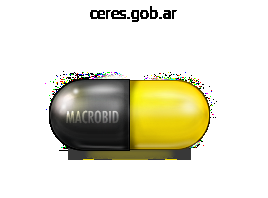
General Information about Macrobid
Macrobid is out there in each oral and intravenous forms, with the oral form being the popular choice for treating UTIs. The recommended dosage and period of treatment could differ relying on the severity of the infection and the affected person's medical history. It is essential to comply with the prescribed therapy plan and complete the full course of treatment as recommended by the healthcare provider to ensure the entire eradication of the infection.
In addition to treating UTIs, Macrobid is also used for the prevention of infections after urologic procedures such as cystoscopy and catheterization. These procedures contain the insertion of medical gadgets into the urinary tract, which might introduce micro organism and increase the chance of an infection. By utilizing Macrobid as a preventive measure, the chance of an infection can be considerably reduced.
One of the main advantages of Macrobid is its capability to pay attention in the urinary tract and remain active for an prolonged time period. This makes it best for the remedy of UTIs, as it can effectively remove the micro organism inflicting the an infection. Furthermore, it additionally has a low risk of developing resistance, making it a reliable treatment choice for recurrent UTIs.
Macrobid, also recognized as nitrofurantoin, is an antimicrobial agent from the nitrofurans group that has been in use for over 60 years. It is particularly designed for the therapy of urinary tract infections (UTIs) and has been proven to be extremely effective in this regard. Moreover, it's also used for the prevention of infections after urologic surgical procedure or procedures similar to cystoscopy and catheterization.
Urinary tract infections are one of the common bacterial infections worldwide, affecting both men and women of all ages. The primary cause of UTIs is bacteria, and the commonest culprit is Escherichia coli (E. coli). These infections can vary from delicate to extreme, with symptoms like burning sensation during urination, frequent urination, and abdominal ache. If left untreated, UTIs can lead to severe complications such as kidney injury and sepsis, especially in vulnerable populations like the aged and people with weakened immune techniques.
In conclusion, Macrobid is an important and highly efficient antimicrobial agent within the remedy of UTIs. Its dual mechanism of action and ability to concentrate in the urinary tract make it an appropriate choice for these suffering from this widespread infection. Moreover, its use in preventing infections after urologic procedures has additionally proven to be beneficial. It is crucial to make use of this medicine judiciously to make sure its efficacy and forestall the event of antibiotic resistance.
While Macrobid is generally well-tolerated, like any treatment, it could have some unwanted effects. Commonly reported unwanted effects include nausea, vomiting, and headache. In uncommon cases, it might trigger allergic reactions or extra extreme unwanted aspect effects corresponding to lung or liver harm. It is important to tell a healthcare supplier of any allergic reactions or medical circumstances before beginning Macrobid treatment.
This is where Macrobid comes into the picture as a extremely efficient therapy option for UTIs. It works by disrupting the permeability of the bacterial cell membrane and inhibiting the production of proteins needed for bacterial progress and replication. This twin mechanism of action makes it highly efficient in treating UTIs caused by a variety of micro organism. In addition, Macrobid can also be efficient against some strains of antibiotic-resistant bacteria, making it an necessary device within the struggle against antimicrobial resistance.
As contrasted with nonjaundiced newborns on the first postnatal day, newborns with overt jaundice in the first 24 postnatal hours are more likely to receive phototherapy (18. Hemolytic disease, immune mediated and otherwise, should be a diagnostic consideration in any infant with early clinical jaundice. Innate ethnic variation in hepatic bilirubin clearance (Ho, 1992) also contributes to the biologic basis of hyperbilirubinemia risk in Asian newborns as revealed by genetic analysis of enzymatic variants that modulate bilirubin metabolism. The high incidence of neonatal hyperbilirubinemia in East Asian populations appears to be at least partly attributable to the prevalence of these hepatic gene polymorphisms. Extravascular red cells have a markedly shortened life span, and their heme fraction is quickly catabolized to bilirubin by tissue macrophages that contain heme oxygenase and biliverdin reductase (Odell, 1980). Thus, cephalhematoma, subdural hemorrhage, massive adrenal hemorrhage, and marked bruising can be associated with increased serum bilirubin levels, typically manifest 48 to 72 hours after the extravasation of blood (Odell, 1980). This temporal pattern is consistent with the evolution of ecchymoses and bilirubin formation in situ and also accounts for why extravascular blood can cause prolonged indirect hyperbilirubinemia (Odell, 1980). An unusual but dramatic example of how extravascular blood can contribute to the genesis of hyperbilirubinemia is found in reports of marked jaundice associated with the delayed absorption of intraperitoneal blood in infants who received fetal intraperitoneal red cell transfusions (Rajagopalan et al, 1984; Wright et al, 1982). In one such case, 13 exchange transfusions were necessary to control the hyperbilirubinemia that resolved only when approximately 87 mL of packed red cells were evacuated from the intraperitoneal cavity (Wright et al, 1982). Although other causes of extravasation generally are not associated with such large amounts of sequestered blood and resultant bilirubin load, they can nevertheless contribute to the development of jaundice. However, an excess risk in siblings independent of other hyperbilirubinemia risk factors expected to recur in sibships (including breastfeeding, lower gestational age, and hemolytic disease) suggests that genetic rather than environmental effects are responsible (Gale et al, 1990; Khoury et al, 1988).
Macrobid Dosage and Price
Macrobid 100mg
- 30 pills - $34.76
- 60 pills - $58.49
- 90 pills - $80.29
- 120 pills - $80.19
- 180 pills - $125.19
- 360 pills - $214.49
Macrobid 50mg
- 120 pills - $118.99
- 180 pills - $157.99
- 360 pills - $305.99
